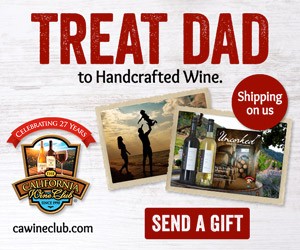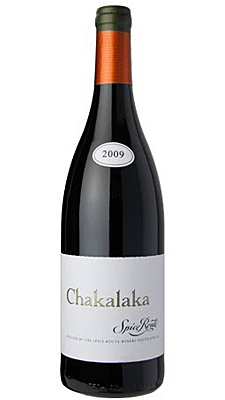Pulling the cork from a wine bottle the other day, I suddenly realized with surprise that I was actually pulling a cork.
Make Dad Smile
He’ll love delicious deliveries of handcrafted California wines. Treat him to a wine gift of 3 months, and The California Wine Club will pay for the shipping.
This offer expires on July 1, 2017. Learn more below, or lick to see the offer now!
A real cork, that is. In that “Eureka” moment, I suddenly realized that it had been a long time since I encountered a whole, natural cork, as opposed to a metal screw cap, synthetic (plastic) stopper, or “technical” cork made of reassembled cork granules treated to deter “cork taint.”
Natural cork is still around, all right. Industry surveys like this 2015 report in Wine Economist, using data from a survey by Wine Business Monthly (registration required), suggest that more bottles are stopped by cork than with all the alternative closures combined.
But the gap is shrinking, Wine Economist writer Mike Veseth reports, with cork usage down from 70 percent to 50 percent of wineries, while screw cap use has increased from about 10% to 30%, technical cork is up from about 20% to 30%, and synthetic closures are roughly stable at about 10%. (The numbers add up to more than 100% because many wineries use more than one closure for different wines, often reserving carefully selected natural cork for the most high-end products where the cork tradition remains strong.)
Confusing the issue further, Veseth points out, “Natural Cork is #1. So are Synthetic Closures. Discuss.” How’s that? Simple: “The devil is in the details. … The unit of analysis for the [Wine Business Monthly] survey is the winery, whether it is big or small, which changes up the conclusions you might otherwise draw. Many more wineries use natural cork, but many more bottles of wine here in the U.S. are sealed by synthetic closures.” The 10 percent of wineries that use synthetics include such giants as Gallo. So, “about half of all wine bottled in the U.S. comes with a synthetic closure even though only about 10% of wineries surveyed use it.”
Perhaps I’m not seeing as many natural corks as in the past because I don’t buy much expensive wine? Could be, but I’d guess that the wines I usually report here are about equally divided between screw cap and technical corks like DIAM, with much smaller incidence of either plastic stoppers or … natural cork.
We’ve come a long way since the early years of the Wine Advisor, when on Nov. 1, 1999, almost 18 years ago, I wrote a then-edgy piece, “Farewell to the cork?” in which I talked about screw caps, synthetics, and even beer bottle-style caps as rarities that might, someday, gain market share in the fight against cork taint. The passage of time makes me look like quite a prophet now. I only wish I were that good in my stock-market picks.
I’d love to know what you think! Drop by our WineLovers Discussion Group forum (WLDG) or our WineLovers Facebook Page and let us know whether you’re seeing less natural cork, and how you feel about that. We’ll welcome your opinions, whatever they are.
Wine Focus: South Africa
We’re discussing South African wines in our WineLovers Discussion Group forum this month in Wine Focus for June 2017: South Africa.
Please feel free to drop by the forum with your tasting notes, comments and questions about South African wine. If you’re a Facebook user, you can join our forum with a single click: All you need to do is visit the forum and click the “Social Login” link at upper right. For another blast from the past, here’s another early Wine Advisor article, Rediscovering South Africa (Sept. 13, 1999), in which I took a look at South African wines while the country’s wine industry was still recovering from its apartheid policies and a long international boycott.
Eighteen years later, South Africa has come a long way. The Mulderbosch 2015 Coastal Region Cabernet Sauvignon Rosé that I reported in last week’s Wine Advisor was very good indeed. Now, the Spice Route 2013 “Chakalaka” Western Cape Red that resided under that natural cork turned out to be a very fine table wine, too. You’ll find my tasting report below.
Today’s Sponsor:
Make Dad Smile
 He’ll love delicious deliveries of handcrafted California wines. Treat him to a wine gift of 3 months, and The California Wine Club will pay for the shipping.
He’ll love delicious deliveries of handcrafted California wines. Treat him to a wine gift of 3 months, and The California Wine Club will pay for the shipping.
Each wine gift from The California Wine Club includes:
• Two award-winning handcrafted and hand-selected wines in each delivery. A different winery is featured every month, making this a true wine adventure for him!
• An elegant bottle stopper.
• $25 Wine Credit.
• A VIP Winery Tasting and Tour invitation.
• Love It Guarantee – They guarantee the utmost satisfaction of you and your gift recipients.
This offer expires on July 1, 2017.
Click to see the offer!
About The California Wine Club
There are thousands of small family wineries handcrafting extraordinary wine in quantities too limited to be found in local stores or shops. In 1990 The California Wine Club Founders Bruce and Pam Boring discovered that these winemaking families were the most passionate in the wine world and that their wines were the hidden gems of wine country! Together Bruce and Pam embarked on a journey to help these artisan wineries introduce their exquisite wines to the world. Learn more.
www.cawineclub.com 1-800-777-4443
Today’s Tasting Report
Spice Route 2013 “Chakalaka” Western Cape Red ($20.99)
 Dark reddish-purple, almost black at the core, with bright ruby glints against the light. Delicious scents of black plums, blackberries and raspberries add just a subtle hint of warm spice in the aroma. Ripe, juicy plums dominate an appetizing flavor shaped by food-friendly acidity and a significant edge of soft but perceptible tannins, with a bit of heat showing from its 14.5% alcohol. Mixed berries and a fresh, citric snap linger in a very long finish. A blend of 50% Syrah, 15% Mourvèdre, 13% Petite Sirah, 8% Carignan, 8% Grenache, and 6% Tannat. U.S. importer: Vineyard Brands, Birmingham, Ala. (June 1, 2017)
Dark reddish-purple, almost black at the core, with bright ruby glints against the light. Delicious scents of black plums, blackberries and raspberries add just a subtle hint of warm spice in the aroma. Ripe, juicy plums dominate an appetizing flavor shaped by food-friendly acidity and a significant edge of soft but perceptible tannins, with a bit of heat showing from its 14.5% alcohol. Mixed berries and a fresh, citric snap linger in a very long finish. A blend of 50% Syrah, 15% Mourvèdre, 13% Petite Sirah, 8% Carignan, 8% Grenache, and 6% Tannat. U.S. importer: Vineyard Brands, Birmingham, Ala. (June 1, 2017)
FOOD MATCH: This wine would go well with just about any red-meat variation or cheese-based dishes. We went the cheese route and were very satisfied with its afflinity for creamy burrata cheese mixed with a spicy, chunky quick Italian-style tomato sauce over linguine.
WHEN TO DRINK: It’s good now, despite the tannins, but would likely reward two or three years in a good cellar; beyond that, its potential for long-term cellaring is anybody’s guess.
VALUE:
My $21 local retail price tag is a bit above the $18 U.S. average on Wine-Searcher.com, but it’s good enough that I’d somewhat grudgingly pay that price again.
WEB LINK
Neither the Spice Route winery website or the website of importer Vineyard Brands offers any information about the Chakalaka red, but the winery site is an attractive destination with good photos of the winery and vineyards and information about its history and terroir.
FIND THIS WINE ONLINE:
Check prices and find vendors for Spice Route “Chakalaka” Western Cape red on Wine-Searcher.com.
Social Media
If you use Facebook, we’d be delighted to have you “Like” our WineLovers Facebook Page. This way you can get Facebook notifications when there’s a new The 30 Second Wine Advisor issue or a topic of particular interest on the WineLovers Discussion Group (WLDG).
If you’re a Facebook user, you can join our forum with a single click! All you need to do is visit the forum and click the “Social Login” link at upper right.
Finally, I welcome social media connections, but if I won’t recognize your name, I suggest that you contact me via Email to wine@wineloverspage.com to let me know that you’ve requested a connection.
Connect with Robin Garr on LinkedIn
Talk About Wine Online
If you have questions, comments or ideas to share about today’s article or wine in general, you’re always welcome to drop by our online WineLovers Discussion Group, the Internet’s first and still the most civil online community. To find our forums, click:
Discussions are open for public viewing, but you must register to post. If you’re a Facebook user, you can also now join our forum with a single click! All you need to do is visit the forum and click the “Social Login” link at upper right.
We use only your name and Email to identify you and make no other claim on your Facebook information or privacy. However, if you prefer not to use Facebook, contact me at wine@wineloverspage.com for information about registration.
Subscriptions and Administrivia
Unsubscribe:
We’re sorry if you must leave us, but simply click the “unsubscribe” link at the bottom of your Email edition to be instantly removed from the mailing list.
Change address:
The quickest and easiest way to change your Email address is simply to register anew, using the link below. If you are keeping your old address but no longer wish to get the Wine Advisor there, click the unsubscribe link below to take it off our list; if you are closing the mailbox, you needn’t take any action, as our system will delete your old address as soon as the mail to your old address starts to “bounce.”
Subscribe to this weekly E-letter (free)
Sponsorship Opportunities:
For information, E-mail wine@wineloverspage.com





